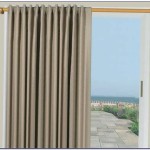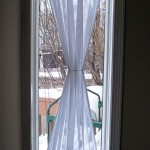How Far to Hang Curtains From a Window
Hanging curtains appears to be a straightforward task, yet achieving a polished and aesthetically pleasing result necessitates careful consideration of various factors, particularly the placement of the curtain rod in relation to the window. The distance from the window at which curtains are hung significantly impacts the perceived size of the window, the amount of natural light entering the room, and the overall visual appeal of the space. Therefore, understanding the principles governing curtain rod placement is essential for maximizing the benefits of window treatments.
The general guideline for hanging curtains involves positioning the rod a few inches above and beyond the window frame. This approach serves to create the illusion of a larger window, allows for greater light penetration when the curtains are open, and provides a more balanced and refined appearance. However, the specific distance may vary based on the dimensions of the window, the style of the curtains, and the desired aesthetic effect.
Determining the Vertical Placement: Hanging Above the Window Frame
The vertical placement of the curtain rod, referring to its distance above the window frame, plays a crucial role in defining the perceived height of the window and the room itself. Mounting the rod higher than the frame effectively elongates the window, making it appear taller and consequently enhancing the sense of vertical space in the room. This is especially beneficial in rooms with low ceilings, as it can create an illusion of greater height and openness.
A general recommendation is to hang the curtain rod approximately 4 to 6 inches above the window frame. This distance provides a noticeable visual lift without appearing disproportionate. However, in rooms with particularly low ceilings, or where the goal is to maximize the perceived height, the rod can be positioned even higher, up to halfway between the window frame and the ceiling. In such instances, it is crucial to ensure that the curtains are long enough to reach the floor, maintaining a consistent and balanced aesthetic.
Conversely, hanging the curtains too close to the window frame can diminish the window's perceived size and make the room feel smaller. This is particularly undesirable in rooms with limited natural light, as it further restricts the amount of sunlight entering the space. Therefore, careful consideration of the vertical placement is paramount in achieving the desired visual effect.
When determining the optimal vertical placement, it is also important to consider the architectural style of the room and the design of the window itself. In rooms with ornate moldings or distinctive window features, the placement of the curtain rod should complement these elements, rather than detracting from them. In some cases, it may be preferable to hang the rod slightly lower to avoid obscuring the architectural details. However, the general principle of hanging above the window frame should still be adhered to as much as possible to maximize the benefits of the window treatment.
Determining the Horizontal Placement: Extending Beyond the Window Frame
The horizontal placement of the curtain rod, referring to the distance it extends beyond the window frame on either side, is equally important as the vertical placement. This extension serves to maximize the amount of natural light entering the room when the curtains are open and to create the illusion of a wider window. By extending the rod beyond the frame, the curtains can be pulled completely clear of the window, allowing unobstructed sunlight to fill the space.
A general recommendation is to extend the curtain rod approximately 3 to 6 inches beyond the window frame on each side. This distance provides sufficient clearance for the curtains to be fully opened without blocking any of the window, thus maximizing light penetration. However, the specific distance may vary depending on the width of the window and the desired aesthetic effect. For narrower windows, a smaller extension may suffice, while for wider windows, a larger extension may be necessary to maintain a balanced appearance.
Extending the curtain rod also contributes to the illusion of a wider window. When the curtains are open, the exposed wall space on either side of the window creates a visual expansion, making the window appear larger than it actually is. This is particularly beneficial in rooms with small or narrow windows, as it can significantly enhance the sense of spaciousness.
However, it is crucial to avoid extending the curtain rod too far beyond the window frame, as this can create an unbalanced and awkward appearance. The extension should be proportionate to the width of the window and the overall dimensions of the room. As a general rule, the extension should not exceed half the width of the window on each side. This ensures that the curtains remain the focal point of the window treatment, rather than the rod itself.
In situations where the window is located close to a corner or an adjacent wall, the horizontal placement may be constrained. In such cases, it is important to prioritize maximizing the light penetration while maintaining a balanced appearance. If there is insufficient space to extend the rod beyond the frame on one side, it may be necessary to compromise on the extension distance, focusing on achieving the best possible result within the given limitations.
Considerations for Curtain Style and Fabric
The style of the curtains and the type of fabric used also influence the optimal distance for hanging them from the window. Different curtain styles require different amounts of space for proper draping and functionality. For example, heavier curtains, such as those made from thick velvet or lined fabrics, typically require more space than lighter curtains, such as those made from sheer or linen fabrics. This is because heavier curtains tend to take up more space when they are gathered or stacked to the side of the window.
Curtains with pleats or other decorative headings also require additional space for the pleats to drape properly. The distance from the window should be sufficient to allow the pleats to hang naturally without being compressed or distorted. In general, curtains with more elaborate headings will require a larger extension beyond the window frame to accommodate the extra fabric.
The length of the curtains is another important factor to consider. Curtains that are designed to puddle on the floor, which is a style often used for a more luxurious or romantic look, will require an extra few inches of fabric. This extra length should be factored into the overall height of the curtain rod to ensure that the curtains hang properly and create the desired effect.
When selecting the fabric for the curtains, it is important to consider its weight and texture. Heavier fabrics will typically require sturdier curtain rods and brackets to support their weight. The distance from the window should also be adjusted accordingly to prevent the curtains from sagging or pulling the rod down. Lighter fabrics, on the other hand, may not require as much support and can be hung closer to the window frame.
Additionally, the color and pattern of the fabric can influence the perceived size of the window. Lighter colors and patterns tend to make the window appear larger, while darker colors and patterns can make it appear smaller. Therefore, the choice of fabric should be carefully considered in relation to the overall dimensions of the window and the desired aesthetic effect.
Ultimately, determining the optimal distance for hanging curtains from a window requires careful consideration of various factors, including the dimensions of the window, the architectural style of the room, the style of the curtains, and the type of fabric used. By adhering to the general guidelines outlined above and taking into account these specific considerations, it is possible to achieve a polished and aesthetically pleasing result that enhances the beauty and functionality of the space.
The goal is to create a window treatment that not only provides privacy and light control but also complements the overall decor of the room and enhances its visual appeal. By paying attention to the details of curtain rod placement, it is possible to transform an ordinary window into a stunning focal point.

How To Install Curtain Rods Best Practices The Shade

How To Hang Curtains Like A Pro Diy Darling

How To Hang Curtains The Right Way Do It Yourself Fun Ideas
How To Hang Curtains In 7 Steps

Hanging Your Curtains Classic Custom Homes Waunakee Wi

Hanging Curtains You Re Probably Doing It Wrong Ask The Expert Style Boston Com Real Estate

How To Hang Curtains The Right Way Painting By Penny

How To Hang Curtains With Crown Molding The Shade

How To Hang Curtains The Right Way

Tips And Tricks For Hanging Drapes Love Your Abode








